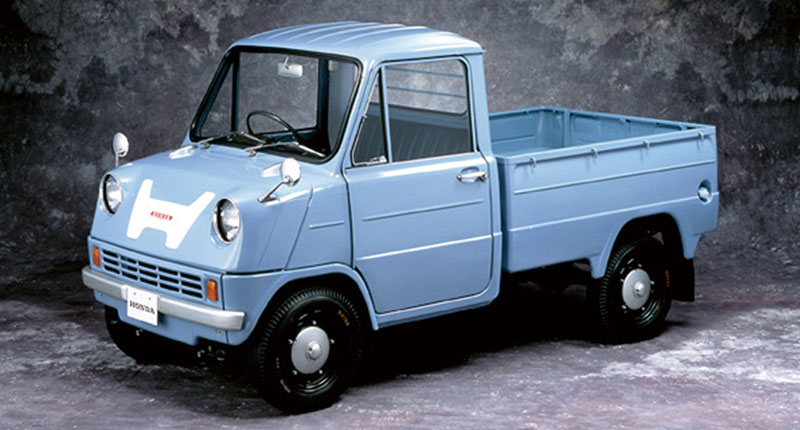Entry in the auto industry
Motorcycle parts paved the way for Moriroku's plastic auto parts business
Plastic auto parts are at the heart of the Moriroku Group's business and the original driver of its technologies. These products are the outcome of Moriroku's early efforts to develop synthetic resins and enter the auto parts industry through its partnership with Honda Motor Company.
Plastic auto parts business launched during Japan's rapid growth period
Japan's period of rapid economic growth started in the mid-1950s, with the chemical industry playing a major role. As the industry shifted from coal-based chemicals to oil-based chemicals, vinyl chloride attracted attention as an innovative new plastic that was both durable and easy to manufacture. Besides its use as a material for consumer goods like shoes, watchbands, and handbags, vinyl chloride could also be used to make water pipes, electric cable sheaths, films and other industrial materials. Backed by interest from both consumers and various industries, Japan's vinyl chloride industry grew rapidly, overtaking England in 1959 as the world's second largest producer.
In 1949, Moriroku began marketing vinyl chloride products made by Mitsui Chemical Industry, and eventually handled most of the sales of these products thanks to its successful efforts to develop the market. Later, Moriroku expanded its product lineup with materials that are used together with vinyl chloride products, including plasticizers, softeners, and stabilizers, as well as pigments and specialized dyes used for coloring them. In 1958, Moriroku became the exclusive distributor of a high-density, high-strength polyethylene material called Hi-Zex, and grew the market for this product by advertising in industry journals.
-

Hi-Zex exhibited at plastic trade shows in the 1960s: Together with manufacturers and marketing firms, Moriroku expanded sales channels for Hi-Zex, a hard polyethylene with very different properties than the soft polyethylene materials that were widely used in the 1950s.
Our first steps as a motorcycle parts manufacturer
In the 1950s, Honda Motor Company began developing an inexpensive motorcycle. To reduce the weight of the motorcycle, Honda replaced metal parts with plastic parts, but the front fairing it designed was large and difficult to press into a single component. The company's engineers studied plastic cups and wash basins that had appeared in the market, and searched for similar materials that could be mass produced. Eventually they found an advertisement for Hi-Zex, and offered Moriroku an opportunity to produce a prototype. Moriroku was not a resin mold manufacturer at that time, but recognizing Honda's offer as a major opportunity, it produced molds at several factories and developed the prototype. Moriroku had already started developing resin materials, but most plastic mold manufacturers at that time made everyday household goods, and none specialized in auto or industrial parts. Moriroku's plastic products department did everything it could to supply the parts to Honda, verifying the prototypes and products countless times at the factories.
In 1958, Honda released the motorcycle it had developed as the Honda Super Cub. Later models were equipped with numerous plastic parts instead of steel. The plastic parts manufactured by Moriroku were the front fairing, tool compartment, and battery compartment. By 1959, just one year after its release, the Super Cub accounted for about 60% of all motorcycles sold in Japan. By 1960, production had reached about 20,000 units per month. The Super Cub's popularity was not limited to Japan—it was also well received in other countries.
Moriroku contributed to the success of the Super Cub line by developing lightweight plastic parts for Honda. Having established itself as a trustworthy and dependable partner, Moriroku was requested to produce all of the prototypes of plastic parts for the car and truck models that Honda announced it would develop in 1962. As a result, Moriroku supplied various parts for Honda's first sports car and compact pickup truck models, including windscreen pillars and steering column covers. The production of these parts was the source of the technical expertise that Moriroku would apply at its factories in the years that followed.
-

The Honda AK360 compact pickup truck: Moriroku began supplying plastic parts for cars and trucks in 1963, including interior and exterior parts for the Honda AK360, a compact pickup powered by a 360cc engine.
The core auto parts business serves as a launchpad for new businesses
Over 60 years ago, Moriroku successfully manufactured molded plastic auto parts made of synthetic resin ahead of other manufacturers in Japan, establishing a new business and a strong relationship with Honda that have lasted to the present day. The auto parts business is still a core business of the Moriroku Group, which has continued to refine technologies and expertise passed down over the generations. Looking ahead, the Moriroku Group is building on the history of this business to venture into new businesses and markets, including next-generation mobility.









